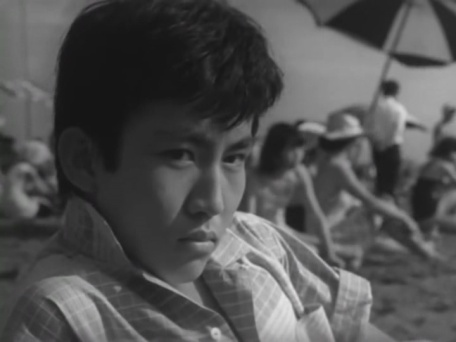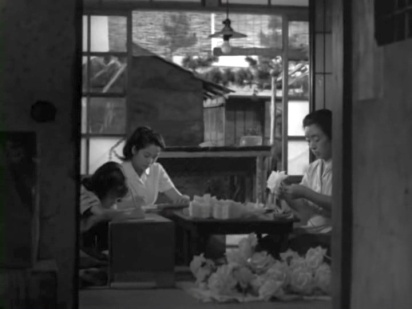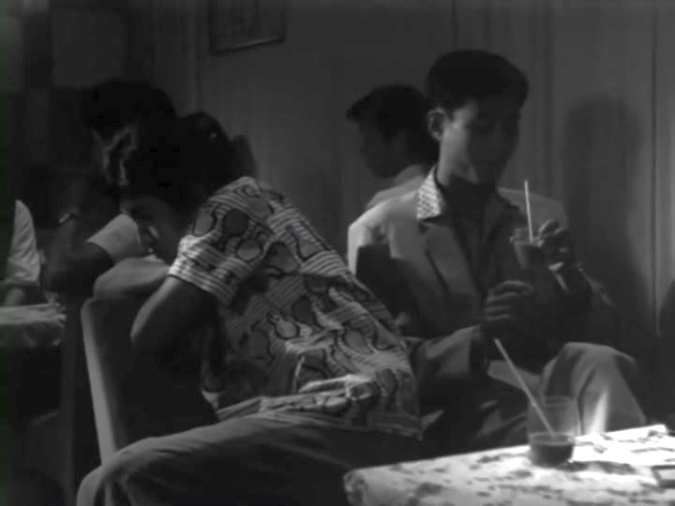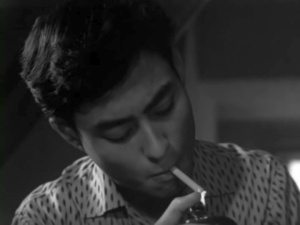 Around 1956, as in America, England, and France, Japan began to notice The Teenager. The most obvious form of this in Japan were the members of the Sun Tribe, as depicted for example, in Crazed Fruit, but a much more vivid and probably accurate depiction of this new phenomenon was in Kinoshita’s The Rose on his Arm.
Around 1956, as in America, England, and France, Japan began to notice The Teenager. The most obvious form of this in Japan were the members of the Sun Tribe, as depicted for example, in Crazed Fruit, but a much more vivid and probably accurate depiction of this new phenomenon was in Kinoshita’s The Rose on his Arm.
How large a group the Sun Tribe might have been is quite debatable, and almost certainly the crack-down on “Sun Tribe movies,” of which there appears to have been precisely one, was an over-reaction. Still, the opening frames of The Rose on His Arm tell us the Sun Tribe role model was immensely influential with some segments of the youth of the day. We begin with a slow pan across a beach full of people at play until we come to rest on Kiyoshi in his Sun Tribe regalia, the Hawaiian shirt with up-turned collar. But he is not having fun at the beach, and his glowering image negates all the happiness in the shot before it comes to rest on him. He is, in fact, what Americans would call a juvenile delinquent, and he is picking his marks. When his buddies stage a crisis in the water, he steals as much as possible from the abandoned purses around him, and dashes off. We’re a long way from the secure rich kids of Crazed Fruit out for an occasional thrill.
Kiyoshi’s mother has struggled to support the family since their repatriation from Palau (a Pacific Island taken by the Japanese from Germany in WWI and then taken again by the US in WWII) and now works several jobs while making paper roses in her spare time with her two younger daughters.

Mom and daughters at their extra work
One of her jobs is housecleaning for a local factory owner, and she finagles a job for her son there. Unfortunately, he comes to the attention of the boss’s son, a genuine Sun Tribe boy who adopts Kiyoshi as essentially a toy to play with. As might be expected, things do not turn out well.
Kiyoshi is what we would today recognize as the quintessential moody teenager, though such a character was utterly unknown in Japanese films, and possibly Japanese society, before this date. Everything upsets him, but he doesn’t know or understand why. He breaks out in bits of rebellion that make no sense, like his petty crimes with his buddies (who all gradually get sent to jail) and even gets a tattoo. Even here the rebellion is confused, for the tattoo is of a rose like those his mother makes. Katsuo Nakamura’s characterization is, to me, one of the most convincing depictions on film of the rootless and irrational immaturity of a young man trying desperately to be mature, on a par with Lou Castel in A Fist in the Pocket and far less actorish than James Dean in East of Eden or Warren Beatty in Splendor in the Grass.* 
Kiyoshi ill-at-ease among his new “friends”
All of this is aided by the casting of Nakamura, who was in fact only about 18 at time of filming and of Akira Ishihama, barely 20, as the rich kid. As noted in other posts, the Japanese studios had a tendency to cast people as their real ages, which provides a layer of reality that is often missing from American films.**
Added to the depiction of the lost teenager, we also get a chance to see the serious class division of the time. There is no doubt that Kiyoshi is seen as worthless by the rich boy,

Rich kid at ease
and even when the rich sister tries to warn him off, he can’t grasp the situation. All he has to live on is confusion and frustration and a complete inability to express that to anyone, even his mother or friends.
Unlike American movies about delinquents, the music here is jazz, not rock-n-roll.
And, once again, there is an open admission of an abortion, which was not a taboo topic at all in Japan or Japanese movies, this time admitted by the rich kid’s older sister.
This is a striking film, told with the visual imagination we would expect from Kinoshita and, at least in my opinion, a far more significant social document than the more famous Crazed Fruit.
- * I haven’t yet seen Punishment Room, also from the same year, which deals with the same kind of character.
- ** I know, I know, there were Mickey Rooney and Judy Garland and, for a while, Deanna Durbin, but I can’t imagine anyone thinking their movies reflected reality. Much more typical in the fifties were Vic Morrow, 27, and Sidney Poitier, 24-5, as the high-schoolers in Blackboard Jungle, or Russ Tamblyn, 26, Tucker Smith, 24, George Chakiris, 25, and Richard Beymer, 22, in West Side Story, where even “Baby John” was 18.
Pingback: Street of Shame / Akasen chitai (1956) | Japanonfilm
Pingback: Conflagration / Temple of the Golden Pavilion / Enjo (1958) | Japanonfilm
Pingback: Everything Goes Wrong / Everything’s Crazy / Subete ga kurutteru (1960) | Japanonfilm
Pingback: Story of Pure Love / Jun’ai monogatari (1957) | Japanonfilm
Pingback: Good for Nothing / Rokudenashi (1960) | Japanonfilm
Pingback: Cruel Story of Youth / Naked Youth / (1960) | Japanonfilm
Pingback: Kisses (1957) | Japanonfilm
Pingback: Live Today, Die Tomorrow / Hadaka no jukyusai (1970) | Japanonfilm
Pingback: Punishment Room / Shokei no heya (1956) | Japanonfilm
Pingback: A Note on Kinoshita | Japanonfilm
Pingback: Yakuza Masterpiece / Ode to Yakuza/ Fine Yakuza Song/ Yakuza zessho (1970) | Japanonfilm